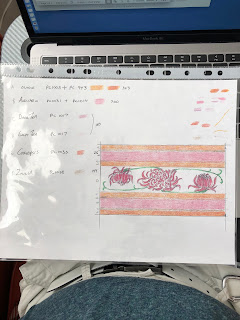Over the winter through March of 2020 I had planned to initiate a small dye garden from a combination of starter plants and seeds. I bought a six-pot dye starter garden online that included weld, coreopsis, woad, chamomile, Japanese indigo, and madder. The planned patio and raised beds had not been done in time to spread beyond this meager dye garden beginning. As we approach this spring 2021, the raised beds will be done and the dye garden will continue to grow. But that is another story.
The chamomile didn’t make it, but the rest took hold. The seeds were Zinnia. I had a single Coreopsis plant and two large pots of Zinnia which flowered all summer long and into fall. It became my ritual to every morning snip off the buds and place them in paper bags awaiting the dye process! The single madder plant continued to grow and grow. The kitchen contributed avocado and onion and coffee grounds to add to the potential color mix. In July, I read True Colors by Keith Recker which included a short report on how a dyer used marigold flowers to create a botanical imprint. I continued to keep the botanical creative fire going by reading various books on natural dye.
In August, sitting in the sun enjoying the quiet and long view across the agriculture fields from the backyard, I finally had an image for the final product for my botanical natural dye desire. It was going to be a warp painted floral pattern done with brighter commercial colors, on a background of natural dyed warp in pinks and yellows from the natural dyestuff. The weft was going to be tea stained. All was planned to be done in cotton.
I try to temper my actions and expressions with moderation. I don’t always succeed. Moderation helps me to keep in balance. I desire to be a naturalist. I am sensitive to the ecological needs of the planet. At the time of this creative activity, I was moving towards more naturalist expressions, hence the desire to grow dye plants, use dye plants in my fiber expressions, and move away from planet harmful fiber activities. My knowledge surely remains incomplete as it is a journey of acquisition. During this project, I thought the striking colors I wanted to achieve outweighed seeking other natural alternatives for the floral pattern. I consider myself a naturalist in desire, but in practice I am in transition. Enough of that, and back to the project.
A cartoon drawing in colored pencil initiated the detail design and plan. At that point the table cloth had become a table cover since I wanted the width to be no more than my maximum cloth width from the LeClerc floor loom. The dyestuff had all been weighed. Research indicated that 10/2 cotton would be suitable for a table cloth. So armed with data and Excel, I calculated the maximum warp widths possible with each of the dye materials. The final design became the iconic inspiration.
My studio roams the house depending on the need. When it’s cold and I need to dye, it’s a movable table in the back hallway. When it’s tolerable weather, and I need space, it’s in the garage. To lay out the warp, and dye the many different dye steps, I needed the space the garage offered, and the longevity of keeping the dye studio available for almost two months. The next step in this botanical table cloth journey was to measure and cut the warp. This was done on a horizontal warping mill in the garage in late September which was a tolerable and comfortable atmosphere. Over the Halloween season I spent almost two months in the garage dye studio. Mordanting came first, then each week was spent using up one or two different natural dyes to color the various warp stripes.
Towards the end of this experience I dithered about using a white or light-colored weft. I was concerned about what would best show up the painted warp. I purchased a dark brown cottolin weft for this purpose. However, I also dyed the entire remaining cone of white cotton in tea to give myself some options. The tea and avocado sections were targeted for the warp painting. I mistakenly applied another mordant step, thinking at the time to ensure the thread would take up the dye. I neglected to research that step, being in a hurry, and ended up removing most of the beautiful pink from the avocado, and a lot of the tea. A hard lesson learned.





No comments:
Post a Comment